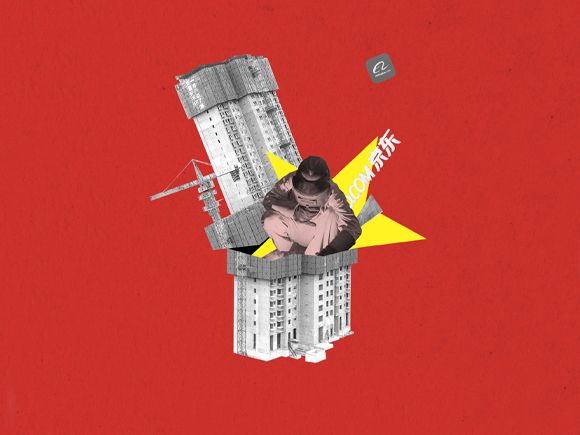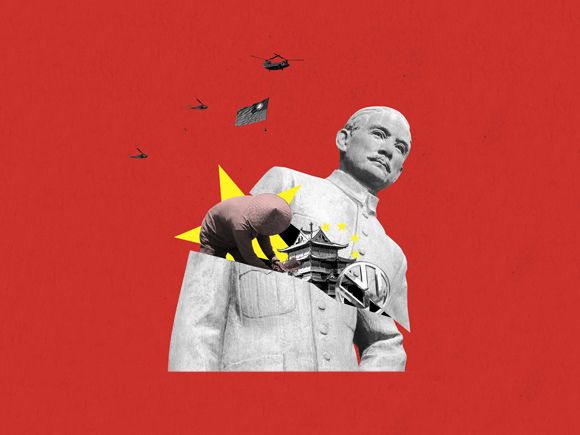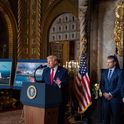Since this article was published, the Chinese government has modified its zero-Covid policy in an apparent desire to calm extensive public protests and stimulate domestic consumption. Isabel Hilton offers an update at the foot of this piece.
In a striking image that circulated on Chinese social media in late November, a young woman in a long leather jacket holds a blank sheet of paper in front of her. Her mouth is sealed with black tape and a length of chain is wound around her waist, the ends fastened on each wrist. She walks slowly, gazing steadily at the camera, along an ordinary street in the province of Zhejiang.
She is protesting, like many in China, against censorship. The symbolism of the blank paper may have its roots in the 2020 demonstrations in Hong Kong, where similar sheets were used by protestors to get around the ban on slogans; it may be because white is a traditional colour of mourning in China. We know no more about her. We do know that life is getting harder for her generation, feeding the discontent that has erupted in extraordinary anti-government demonstrations across the country of late. The trigger for this has been President Xi Jinping’s brutal—and apparently endless—zero-Covid policy.
The costs of that policy to the wider economy have accumulated dramatically since it was first implemented in Wuhan in 2019. China’s economic activity crashed when the pandemic went global, and since then, a stable recovery has been stymied by an inadequate vaccine rollout and the draconian city lockdowns that persist to this day. The lockdowns have added both fuel to popular discontent and weight to the pressures on the Chinese economy, but those pressures—and the government’s struggles to address them—go back much further.
China’s sagging economy has removed one of the key advantages that the Communist Party has enjoyed in enforcing social control. Since the last major protests in China, the Tiananmen Square occupation in 1989, the government has essentially offered its people a bargain: stay out of politics and we will make you rich. Today, that seems like a hollow promise.
Until the shocks of the last three years, many thought China was on track to become the world’s biggest economy. The country’s growth, and the support it provided for global markets, seemed assured.
But well before Covid cast its dark shadow, there was a growing body of evidence pointing to structural issues in the country’s economic model. If unaddressed, these could change that confident narrative sharply, with profound implications for a world of deeply entangled supply chains and high levels of mutual dependency.
The UK could house its entire population in China’s unused apartments and there would still be masses of room left over
The first and most obvious challenge China was facing before the pandemic was the impending middle-income trap. This describes the risk to an economy that has enjoyed rapid initial growth by exploiting its advantages—often a surplus of cheap labour that can be moved off the land and into the cash economy—but that stalls as living standards and costs rise. Without becoming more efficient and producing higher value goods and services, it is hard to avoid stagnation. Most emerging economies get stuck in this middle-income trap, finding the technology gap between advanced and emerging nations too big to close. There have been exceptions, including Israel and Asian economies such as South Korea, Singapore and Japan. But many others, like Brazil, have failed to escape.
China’s planners were well aware of the dangers of the middle-income trap. By the middle of the 2000s, they had begun to invest in a higher-value future. The language of recent “five-year plans”—the grand economic strategies worked up twice a decade by the Chinese Communist Party (CCP)—reflects both the anxiety at any prospect of stalling progress and the ambition to dominate the new century. Among the sectors that China identified early for investment was low-carbon technology—solar panels, wind turbines, electric vehicles, batteries—in which it set out to establish a global monopoly. This proved largely successful, with China establishing strong positions in those sectors.
Other adjustments, however, have fared less well. One other key policy that the country has struggled to deliver in recent years is the so-called “dual circulation” policy. This aims to maintain China’s openness to international investment but reduce dependence on exports—typically the key driver of the first stage of rapid growth—while building resilience through greater consumption of goods and, crucially, services in domestic markets.
While low-added-value manufacturing is shifting out of the country to other emerging economies, the performance of China’s domestic market has been disappointing. Although services have increased as a proportion of economic activity, the country’s growth targets—much lower than in the past—have been missed. At the same time, despite China’s insistence that it remains open to investment, the disruptions of the pandemic, mounting international tensions and growing worries about the possibility of an armed confrontation over Taiwan have made many investors wary.

There are also longer-term worries. Many analysts now believe that China’s past growth was less soundly based than it appeared. A key driver in the first stage of development in a country transitioning from a rural to an urban, higher-wage society is the building of the infrastructure and housing that the growing economy needs. Over the past 30 years, China has been one vast building site: shiny new cities, marching ranks of tower blocks, motorways, subways, airports, high-speed rail lines and big hydroelectric dams—all proliferating at dizzying speed, transforming in just a few decades a landscape that had changed relatively little in the previous century.
That activity stimulated growth but it also needed to be financed, and over the decades the infrastructure and construction debts carried by China’s provincial and local governments have ballooned. As long as the infrastructure was creating value, those debt levels seemed sustainable. But today they are causing serious concern.
China’s debt-driven construction frenzy was exacerbated by a number of other factors peculiar to the country. Moving the workforce off the land and into the factories was always going to create demand for housing. At the same time, however, a rising middle class had been accumulating savings and was looking for somewhere to invest. The class of asset that seemed to offer guaranteed growth was residential property, so they invested—often in two or three spare apartments that were never lived in, but that represented financial security and future returns.
China’s local authorities, meanwhile, were chronically strapped for cash because central government took a large share of tax revenues for itself. To close the gap between income and expenditure, local and provincial governments took over agricultural land, re-designated it as land for development and borrowed to build, relying on ever-rising prices to balance the books. It all added up to a massive housing boom.
The debt mountains grew relatively slowly at first, but then came the global financial crash in 2007–8. To shield the domestic economy from the fallout, the government announced the world’s largest fiscal stimulus, spending four trillion yuan ($587bn), largely on shovel-ready infrastructure projects. Of this, 1.18 trillion yuan was committed by central government, with banks and local governments making up the rest. In all, China spent 12.5 per cent of its 2008 GDP over 27 months. In relative terms, this was equal to three times the effort in the United States.
It worked in the short term: China suffered a sharp downturn in 2008, but achieved an impressive 8.7 per cent growth the following year and managed 10.4 per cent in 2010, at least according to government statistics. The demand created by the stimulus meant that many countries that supplied raw materials to China prospered, defying the global downturn. China was the first major country to recover from the financial crash, but the debt hangover was severe. Debt worries rose further when China deployed the same kind of approach to recovery from the Covid shock. The country’s headline economic growth was concealing an unhealthy dependency on pouring concrete, an activity that was generating rapidly diminishing returns and ever-more debt.
Prospects of repaying that debt steadily worsened as the engine of China’s gigantic property market began to sputter; by October 2021, the country’s National Bureau of Statistics reported that the price of residential property was declining nationwide. A key factor in the downturn was a massive oversupply of housing: according to a calculation reported in the Financial Times, China had enough empty apartments to accommodate 90m people. In theory, the UK could house its entire population in China’s unused apartments and there would still be masses of room left over.
This oversupply was not driven by demand, but by the role that property development had come to play in local government finance and retail investment. Although contributing at least 30 per cent of China’s GDP, it was completely unsustainable—and by the close of the second decade of the 21st century, it was in crisis.
The zero-Covid protests, with their scattered but clear calls for an end to the dictatorship, have dented the party’s image
The scale of property’s contribution to the economy had helped to mask other weaknesses—like the decline in total factor productivity, a comprehensive measure for how much output is produced from given inputs. But as demand slackened and the mountain of debt threatened to drag down growth, the vast property companies themselves became a threat to China’s economic stability.
By 2021, Evergrande, the world’s largest property company, was also its most leveraged, carrying a burden of $300bn in debt which, in a slowing market, investors increasingly doubted that it could pay. From Beijing’s perspective, Evergrande’s situation was more and more threatening: valued at $41bn in 2020, by the end of 2021 it was priced at less than $4bn and was struggling to meet scheduled interest payments on its dollar-denominated bonds.
It was not the only property company in trouble. In 2020, the government had tried to restrain the rapidly rising surplus of apartments by restricting the flow of finance to property firms. Now they were unable to service their existing debts or finance building new apartments for which, in many cases, prospective homeowners had already paid, or were committed to pay.
Apart from the economic shock of a default, there were serious social implications: if Evergrande defaulted, angry citizens would blame the government for failing to protect their interests. Evergrande, the government concluded, could not be allowed to collapse—but at the same time the merry-go-round must stop. The spectacular demolition of 15 unfinished tower blocks in the city of Kunming in August 2021 seemed like an apt illustration of the sector’s crisis. Thousands of Evergrande’s customers were also withholding payment—anxious that the company would not finish building their apartments, they had gone on a mortgage strike.
In December 2021, Evergrande defaulted on its US dollar bonds despite weeks of frantic effort to raise enough cash in time. The company scrambled to reassure its domestic and international bond holders that the situation was under control and that a restructuring plan would be in place by mid-2022. As international investors threatened legal action, several other major developers also sought protection from creditors. Property prices and sales across China both declined sharply. Evergrande’s mid-2022 deadline came and went without a plan.
The slow-burning property sector crisis was not the only shadow over the Chinese economy. Another major driver, the building of infrastructure, had also run out of steam. Japan had reached a similar point in the 1990s: overbuilt in infrastructure, with surplus capacity in steel and cement and skills with nowhere to go, the country adopted an outward-facing development approach, building infrastructure on continental Asia. Not only would that relieve the pressures at home, the government believed, but it would deliver diplomatic and economic benefits for Japan.

In 2013, Xi Jinping launched the gargantuan Belt and Road initiative to build infrastructure outside China, adopting the same approach as Japan. Several years of exuberant activity followed, but the economic impacts of the pandemic have left many host countries unable to repay Beijing and China must now manage their debts. New investment in the initiative has fallen since 2017.
In November 2013, the CCP announced a series of important economic reforms, referred to as the Third Plenum Reforms (the party’s Central Committee was having its third plenary session under its new leadership). The Third Plenum has often marked important economic moments: Deng Xiaoping announced that China would open to the world at the Third Plenum in 1978, and in 1993 the reformer Zhu Rongji declared the dawn of the “socialist market economy” and began to dismantle many of China’s state-owned industries.
The 2013 reforms revealed a plan to boost the private sector—particularly China’s vigorous small- and medium-sized enterprises, which had difficulty accessing finance; to improve the free market’s capacity to allocate resources; and to give farmers more rights over their land.
It seemed to signal a dynamic shift in China’s approach, but those promised reforms were never fully implemented and, less than a decade later, policy has reversed. The party has reinforced the pre-eminence of the state sector and asserted political control over much of the private sector—either through punitive regulation, as in the case of several of China’s tech giants, or through mandated party involvement in decisionmaking by executive boards.
And when repeated global shocks have threatened China’s domestic economy, the CCP has reached for the worn lever of infrastructure building to administer an adrenaline boost, each time digging the economy into a deeper hole.
It is not all a story of failure: China’s investment in new technologies and determination to move up the value chain has had many positive results. But the country has not yet reached the technological heights it was aiming for. In the sensitive field of advanced microchips, for instance, manufacturers have remained dependent on imports. Growing tensions with the US and trade sanctions introduced by Donald Trump (and ramped up by Joe Biden) have severely impacted some flagship companies, including Huawei. This atmosphere, plus the concerns held about China’s strategic direction by its biggest trade partner, the EU, has led to talk in western capitals of “re-shoring”, “friend-shoring” and “near-shoring” as responses to entangled supply chains and mutual dependencies in a context of mounting
mutual suspicion.
As China’s economy slackens, foreign investors and foreign companies operating in the country have become increasingly vocal about the difficulties they experience in its market. Even in Germany—which enjoys Europe’s most successful trading relationship with China—a fierce national debate was triggered after chancellor Olaf Scholz visited Beijing in November 2022.
On one hand, Germany’s car industry has more than €33bn of investment in China, which Volkswagen calls its “second home market”; both BMW and Audi are expanding operations. In 2021, German carmakers accounted for 42 per cent of the EU’s total foreign direct investment
in China. On the other hand, EU and German concerns about China’s strategic direction have cast doubt on the longstanding faith in Wandel durch Handel, or “change through trade”—the idea that trading with authoritarian regimes encourages them to make positive political reforms. Many influential Germans now perceive China as a potential predator that is prepared to weaponise trade relations in pursuit of geopolitical goals, and argue that it is imperative for Germany to reduce its dependency.
These accumulating woes were the backdrop to October’s highly significant 20th Party Congress, at which Xi—concurrently China’s president and, more importantly, general secretary of the CCP and head of its Central Military Commission—sought a third five-year term.
At stake at the congress was Xi’s future: his success in filling the top posts with his loyalists—in the Politburo, its Standing Committee, and the Central Committee—would signal how far his ideas would be subject to negotiation. We would learn whether the steadily increasing party control of the economy and wider Chinese culture and society was likely to continue unchecked, while Xi’s choices of promotions to the military commission could signal intentions on the military harassment of Taiwan.
When the new CCP committees were revealed, China’s stock markets crashed: Xi’s choices signalled to the markets that politics mattered more than the economy. He secured his third term—and with no successor in sight, that may well extend to a fourth. The nature and scale of the zero-Covid protests, with their scattered but clear calls for an end to the dictatorship, have dented the party’s image and challenged Xi’s claims to popularity, but they are unlikely to shake the party’s grip on power. Xi’s policies will set China’s direction for the foreseeable future, despite the manifest unhappiness in the international headlines.
The era of reform and opening, Deng Xiaoping’s great legacy and the foundation of China’s last four decades of growth, is over. This year, China’s economy has grown less than those of its neighbours for the first time in decades. Young people contemplate shrinking prospects, local governments find no relief for their budgetary crises, the population ages in a landscape of largely unfunded pensions, and the world may soon plunge into recession. In the last global economic crisis, US and Chinese officials worked together to minimise the shock and promote global recovery. This time round, it looks like it will be every leader for himself.
Postscript: China’s new Covid rules—announced on 7th December—offer 10 changes, relaxing the need for a PCR test to access transport, work or social venues and providing the option of quarantine at home instead of in a government centre. They make the distinction between high-risk and non-high-risk areas and shift the focus to mass vaccination of the elderly.
The government explanation for its unexpected U-turn is that Chinese scientists have concluded that Omicron is less lethal than previous versions of the virus. While true, opening up remains a risky bet for the Party, as long as parts of the Chinese population remain under or poorly vaccinated.













